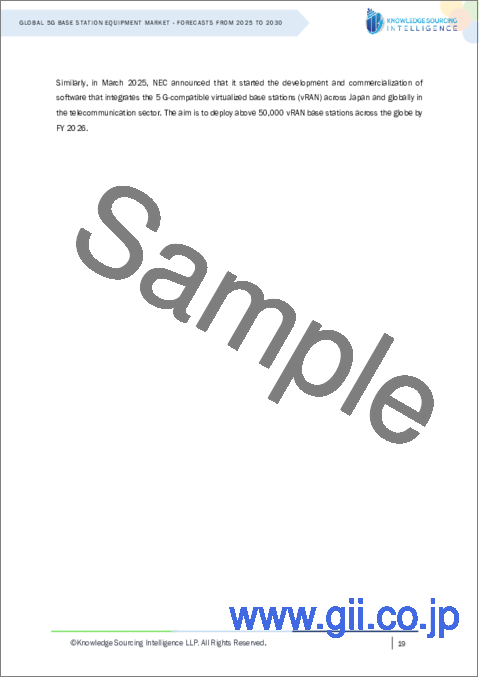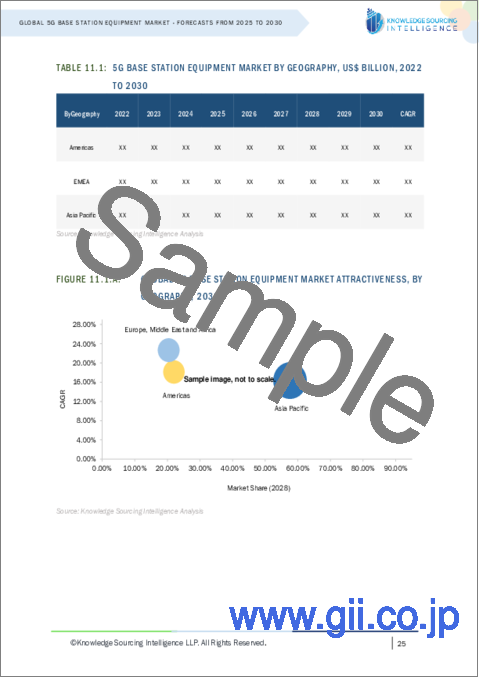|
|
市場調査レポート
商品コード
1649408
5G基地局装置市場:予測(2025年~2030年)5G Base Station Equipment Market - Forecasts from 2025 to 2030 |
||||||
カスタマイズ可能
|
|||||||
| 5G基地局装置市場:予測(2025年~2030年) |
|
出版日: 2025年01月02日
発行: Knowledge Sourcing Intelligence
ページ情報: 英文 138 Pages
納期: 即日から翌営業日
|
全表示
- 概要
- 目次
5G基地局装置市場は、2025年の298億6,500万米ドルから2030年には527億3,300万米ドルに達し、CAGR 12.04%で成長すると推定されます。
5G基地局は、次世代ワイヤレスネットワークのバックボーンを形成し、帯域幅の強化、超低遅延、広範なカバレッジを可能にすることで、高まる接続需要をサポートします。スマートフォンの急速な普及(ITUによると、2023年の世界の携帯電話所有率は78%)とインターネット利用の急増に後押しされ、市場は力強い成長を遂げようとしています。人口の81%がインターネットを利用する都市部(農村部では50%)は、より高密度なネットワーク要件と急速な都市化が後押しし、重要な展開拠点となっています。
主な成長要因
- 都市化とインターネット普及:世界の都市人口は44億6,000万人(2021年)から46億1,000万人(2023年)に増加し、高速接続に対する需要が高まっています。インターネット普及率では欧州がトップ(92%)、次いで南北アメリカ(90%)、アジア太平洋(80%)となっています。
- スマートフォンとデータ需要:特に新興経済圏では、インターネット接続のためのモバイル機器利用が増加しており、トラフィックとユーザーの期待を管理するために5Gインフラのアップグレードが必要となっています。
地理的洞察
- アジア太平洋地域は、インドの積極的な5G展開に牽引され、成長を独占しています。同国は、国産通信開発基金、周波数オークション、テストベッドなどの政府のイニシアティブに支えられ、2023年に5Gカバー率90%を達成しました。インドの5G分野は2024年までに4,550億米ドルの経済貢献が予測されています。
- モバイルファーストの動向:インドのインターネットアクセスの82%はモバイル機器経由であり、この地域はスマートフォン依存と5Gインフラ需要の関連性を例証しています。
今後の見通し
インドの2030年5Gロードマップのような政府の政策や世界の都市化の動向は、今後も基地局設備への投資を促進すると思われます。このインフラは、接続性の拡大とIoTやスマートシティなどの次世代用途のサポートという2つの需要を満たすために不可欠です。
本レポートを購入する理由
- 洞察に満ちた分析:顧客セグメント、政府政策と社会経済要因、消費者嗜好、産業別、その他のサブセグメントに焦点を当て、主要地域だけでなく新興地域もカバーする詳細な市場考察を得ることができます。
- 競合情勢:世界の主要企業が採用する戦略的策略を理解し、適切な戦略による市場浸透の可能性を理解することができます。
- 市場動向と促進要因:ダイナミックな要因と極めて重要な市場動向、そしてそれらが今後の市場展開をどのように形成していくかを探ります。
- 実行可能な提言:ダイナミックな環境の中で新たなビジネスストリームと収益を発掘するための戦略的決断を下すために、洞察を活用します。
- 幅広い利用者に対応:新興企業、研究機関、コンサルタント、中小企業、大企業にとって有益で費用対効果の高いです。
どのような用途で利用されていますか?
業界・市場考察、事業機会評価、製品需要予測、市場参入戦略、地理的拡大、設備投資決定、規制の影響、新製品開拓、競合情報
調査範囲
- 2022年から2030年までの過去データおよび予測
- 成長機会、課題、サプライチェーンの展望、規制枠組み、顧客行動、およびトレンド分析
- 競合のポジショニング、戦略、および市場シェア分析
- 収益の成長とセグメント別および地域別の予測分析
- 企業プロファイリング(戦略、製品、財務情報、主要動向など)
5G基地局装置市場は以下のようにセグメント化されています:
展開別
- 都市部
- 農村部
アーキテクチャ別
- AAU
- BBU
技術別
- O-RAN
- 従来型RAN
構成別
- スタンドアロン
- 非スタンドアロン
周波数帯域別
- 6GHz未満
- ミリ波
地域別
- 北米
- 米国
- カナダ
- メキシコ
- 南米
- ブラジル
- アルゼンチン
- その他
- 欧州
- 英国
- ドイツ
- フランス
- イタリア
- スペイン
- その他
- 中東・アフリカ
- サウジアラビア
- UAE
- その他
- アジア太平洋
- 中国
- 日本
- 韓国
- インド
- インドネシア
- タイ
- 台湾
- その他
目次
第1章 イントロダクション
- 市場概要
- 市場の定義
- 調査範囲
- 市場セグメンテーション
- 通貨
- 前提条件
- 基準年と予測年のタイムライン
- 利害関係者にとっての主なメリット
第2章 調査手法
- 調査デザイン
- 調査プロセス
第3章 エグゼクティブサマリー
- 主な調査結果
第4章 市場力学
- 市場促進要因
- 市場抑制要因
- ポーターのファイブフォース分析
- 業界バリューチェーン分析
- アナリストビュー
第5章 5G基地局装置市場:展開別
- イントロダクション
- 都市部
- 農村部
第6章 5G基地局装置市場:アーキテクチャ別
- イントロダクション
- AAU
- BBU
第7章 5G基地局装置市場:技術別
- イントロダクション
- O-RAN
- 従来のRAN
第8章 5G基地局装置市場:構成別
- イントロダクション
- スタンドアロン
- 非スタンドアロン
第9章 5G基地局装置市場:周波数帯域別
- イントロダクション
- 6GHz未満
- ミリ波
第10章 5G基地局装置市場:地域別
- イントロダクション
- 北米
- 展開別
- アーキテクチャ別
- 技術別
- 構成別
- 周波数帯域別
- 国別
- 南米
- 展開別
- アーキテクチャ別
- 技術別
- 構成別
- 周波数帯域別
- 国別
- 欧州
- 展開別
- アーキテクチャ別
- 技術別
- 構成別
- 周波数帯域別
- 国別
- 中東・アフリカ
- 展開別
- アーキテクチャ別
- 技術別
- 構成別
- 周波数帯域別
- 国別
- アジア太平洋
- 展開別
- アーキテクチャ別
- 技術別
- 構成別
- 周波数帯域別
- 国別
第11章 競合環境と分析
- 主要企業と戦略分析
- 市場シェア分析
- 合併、買収、合意およびコラボレーション
- 競合ダッシュボード
第12章 企業プロファイル
- NEC
- Fujitsu
- Huawei Technologies Co., Ltd.
- Samsung
- ZTE
- Nokia
- Ericsson
- Intel
- 3M
- WiSig Networks Pvt. Ltd.
- Murata Manufacturing Co.
- Mavenir
- Cisco Systems, Inc.
The 5G base station equipment market is estimated to reach US$52.733 billion by 2030 from US$29.865 billion in 2025, growing at a CAGR of 12.04%.
5G base stations form the backbone of next-generation wireless networks, enabling enhanced bandwidth, ultra-low latency, and broader coverage to support rising connectivity demands. Driven by surging smartphone adoption (78% global mobile ownership in 2023, per ITU) and escalating internet usage, the market is poised for robust growth. Urban areas, where 81% of populations use the internet (vs. 50% in rural regions), are key deployment hubs, fueled by denser network requirements and rapid urbanization.
Key Growth Drivers
- Urbanization & Internet Penetration: Global urban populations grew from 4.46 billion (2021) to 4.61 billion (2023), intensifying demand for high-speed connectivity. Europe leads in internet adoption (92%), followed by the Americas (90%) and Asia-Pacific (80%).
- Smartphone & Data Demand: Rising mobile device usage for internet access, particularly in emerging economies, necessitates 5G infrastructure upgrades to manage traffic and user expectations.
Geographical Insights
- Asia-Pacific dominates growth, led by India's aggressive 5G rollout. The country achieved 90% 5G coverage in 2023, supported by government initiatives like indigenous telecom development funds, spectrum auctions, and test beds. India's 5G sector is projected to contribute $455 billion to its economy by 2024.
- Mobile-First Trends: With 82% of India's internet access via mobile devices, the region exemplifies the link between smartphone dependency and 5G infrastructure demand.
Future Outlook
Government policies, such as India's 2030 5G roadmap, and global urbanization trends will continue to drive investments in base station equipment. This infrastructure is critical to meeting the dual demands of expanding connectivity and supporting next-gen applications like IoT and smart cities.
Reasons for buying this report:-
- Insightful Analysis: Gain detailed market insights covering major as well as emerging geographical regions, focusing on customer segments, government policies and socio-economic factors, consumer preferences, industry verticals, other sub- segments.
- Competitive Landscape: Understand the strategic maneuvers employed by key players globally to understand possible market penetration with the correct strategy.
- Market Drivers & Future Trends: Explore the dynamic factors and pivotal market trends and how they will shape up future market developments.
- Actionable Recommendations: Utilize the insights to exercise strategic decision to uncover new business streams and revenues in a dynamic environment.
- Caters to a Wide Audience: Beneficial and cost-effective for startups, research institutions, consultants, SMEs, and large enterprises.
What do businesses use our reports for?
Industry and Market Insights, Opportunity Assessment, Product Demand Forecasting, Market Entry Strategy, Geographical Expansion, Capital Investment Decisions, Regulatory Framework & Implications, New Product Development, Competitive Intelligence
Report Coverage:
- Historical data & forecasts from 2022 to 2030
- Growth Opportunities, Challenges, Supply Chain Outlook, Regulatory Framework, Customer Behaviour, and Trend Analysis
- Competitive Positioning, Strategies, and Market Share Analysis
- Revenue Growth and Forecast Assessment of segments and regions including countries
- Company Profiling (Strategies, Products, Financial Information, and Key Developments among others)
The 5G base station equipment market has been segmented as following:
By Deployment
- Urban
- Rural
By Architecture
- AAU
- BBU
By Technology
- O-RAN
- Traditional RAN
By Configuration
- Standalone
- Non-Standalone
By Frequency Band
- Sub-6-Ghz
- mmWave
By Geography
- North America
- United States
- Canada
- Mexico
- South America
- Brazil
- Argentina
- Others
- Europe
- United Kingdom
- Germany
- France
- Italy
- Spain
- Others
- Middle East and Africa
- Saudi Arabia
- UAE
- Others
- Asia Pacific Region
- China
- Japan
- South Korea
- India
- Indonesia
- Thailand
- Taiwan
- Others
TABLE OF CONTENTS
1. INTRODUCTION
- 1.1. Market Overview
- 1.2. Market Definition
- 1.3. Scope of the Study
- 1.4. Market Segmentation
- 1.5. Currency
- 1.6. Assumptions
- 1.7. Base and Forecast Years Timeline
- 1.8. Key benefits for the stakeholders
2. RESEARCH METHODOLOGY
- 2.1. Research Design
- 2.2. Research Process
3. EXECUTIVE SUMMARY
- 3.1. Key Findings
4. MARKET DYNAMICS
- 4.1. Market Drivers
- 4.2. Market Restraints
- 4.3. Porter's Five Forces Analysis
- 4.3.1. Bargaining Power of Suppliers
- 4.3.2. Bargaining Power of Buyers
- 4.3.3. The Threat of New Entrants
- 4.3.4. Threat of Substitutes
- 4.3.5. Competitive Rivalry in the Industry
- 4.4. Industry Value Chain Analysis
- 4.5. Analyst View
5. 5G BASE STATION EQUIPMENT MARKET BY DEPLOYMENT
- 5.1. Introduction
- 5.2. Urban
- 5.3. Rural
6. 5G BASE STATION EQUIPMENT MARKET BY ARCHITECTURE
- 6.1. Introduction
- 6.2. AAU
- 6.3. BBU
7. 5G BASE STATION EQUIPMENT MARKET BY TECHNOLOGY
- 7.1. Introduction
- 7.2. O-RAN
- 7.3. Traditional RAN
8. 5G BASE STATION EQUIPMENT MARKET BY CONFIGURATION
- 8.1. Introduction
- 8.2. Standalone
- 8.3. Non-Standalone
9. 5G BASE STATION EQUIPMENT MARKET BY FREQUENCY BAND
- 9.1. Introduction
- 9.2. Sub-6-Ghz
- 9.3. mmWave
10. 5G BASE STATION EQUIPMENT MARKET BY GEOGRAPHY
- 10.1. Introduction
- 10.2. North America
- 10.2.1. By Deployment
- 10.2.2. By Architecture
- 10.2.3. By Technology
- 10.2.4. By Configuration
- 10.2.5. By Frequency Band
- 10.2.6. By Country
- 10.2.6.1. United States
- 10.2.6.2. Canada
- 10.2.6.3. Mexico
- 10.3. South America
- 10.3.1. By Deployment
- 10.3.2. By Architecture
- 10.3.3. By Technology
- 10.3.4. By Configuration
- 10.3.5. By Frequency Band
- 10.3.6. By Country
- 10.3.6.1. Brazil
- 10.3.6.2. Argentina
- 10.3.6.3. Others
- 10.4. Europe
- 10.4.1. By Deployment
- 10.4.2. By Architecture
- 10.4.3. By Technology
- 10.4.4. By Configuration
- 10.4.5. By Frequency Band
- 10.4.6. By Country
- 10.4.6.1. United Kingdom
- 10.4.6.2. France
- 10.4.6.3. Germany
- 10.4.6.4. Italy
- 10.4.6.5. Spain
- 10.4.6.6. Others
- 10.5. Middle East and Africa
- 10.5.1. By Deployment
- 10.5.2. By Architecture
- 10.5.3. By Technology
- 10.5.4. By Configuration
- 10.5.5. By Frequency Band
- 10.5.6. By Country
- 10.5.6.1. Saudi Arabia
- 10.5.6.2. UAE
- 10.5.6.3. Others
- 10.6. Asia Pacific
- 10.6.1. By Deployment
- 10.6.2. By Architecture
- 10.6.3. By Technology
- 10.6.4. By Configuration
- 10.6.5. By Frequency Band
- 10.6.6. By Country
- 10.6.6.1. China
- 10.6.6.2. Japan
- 10.6.6.3. South Korea
- 10.6.6.4. India
- 10.6.6.5. Indonesia
- 10.6.6.6. Thailand
- 10.6.6.7. Taiwan
- 10.6.6.8. Others
11. COMPETITIVE ENVIRONMENT AND ANALYSIS
- 11.1. Major Players and Strategy Analysis
- 11.2. Market Share Analysis
- 11.3. Mergers, Acquisitions, Agreements, and Collaborations
- 11.4. Competitive Dashboard
12. COMPANY PROFILES
- 12.1. NEC
- 12.2. Fujitsu
- 12.3. Huawei Technologies Co., Ltd.
- 12.4. Samsung
- 12.5. ZTE
- 12.6. Nokia
- 12.7. Ericsson
- 12.8. Intel
- 12.9. 3M
- 12.10. WiSig Networks Pvt. Ltd.
- 12.11. Murata Manufacturing Co.
- 12.12. Mavenir
- 12.13. Cisco Systems, Inc.






